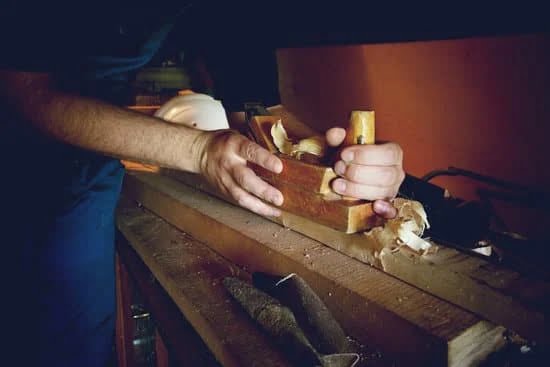Are you wondering what to make in woodworking? Woodworking is a beloved craft that offers a wide range of projects and possibilities for both beginners and experienced woodworkers. From functional furniture to artistic carvings, the world of woodworking is filled with opportunities for creativity and practicality.
Woodworking encompasses a diverse array of projects, each offering a unique blend of skill, precision, and artistry. Whether you’re interested in creating beautiful furniture pieces or intricate decorative items, woodworking provides an outlet for self-expression and craftsmanship. With the right tools and techniques, the possibilities are endless in this captivating craft.
In this article, we’ll explore the world of woodworking and delve into the various types of projects that you can take on. From essential tools for beginners to advanced carving techniques, there’s something for everyone to explore within the realm of woodworking. So grab your chisels and measuring devices as we embark on a journey into the captivating world of woodworking.
Tools of the Trade
Woodworking is a rewarding and creative craft that allows individuals to create beautiful and functional pieces from wood. To get started in woodworking, it is essential to have the right tools. Whether you are a beginner or an experienced woodworker, having the necessary tools of the trade is crucial for the success of your projects.
One of the most important tools for any woodworker is a saw. There are various types of saws available, including hand saws and power saws, each serving different purposes in woodworking. Chisels are also essential for carving and shaping wood, while planes are used for smoothing and leveling surfaces. Additionally, accurate measuring devices such as tape measures, squares, and rulers are indispensable for ensuring precision in woodworking projects.
For beginners looking to start their woodworking journey, investing in a set of high-quality tools will set them on the right path. As one gains experience in woodworking, they may consider expanding their tool collection to include more specialized items based on their interests and project requirements.
| Tool | Use |
|---|---|
| Saw | Cutting wood into desired shapes and sizes |
| Chisel | Carving and shaping wood |
| Plane | Smoothing and leveling wooden surfaces |
| Measuring Devices (tape measure, square, ruler) | Ensuring accurate measurements for precise woodworking projects |
Functional Projects
Woodworking offers a wide array of possibilities for creating functional and visually appealing furniture and home décor items. Whether you are a seasoned woodworker or just starting out, there are countless projects that you can undertake to enhance your living space. Here are some popular woodworking projects for the home:
- Building Tables: From coffee tables to dining tables, building your own table can be a rewarding woodworking project. You can customize the size, shape, and finish to match your personal style and home décor.
- Crafting Chairs: Creating chairs out of wood allows you to add a personal touch to your seating arrangements. Whether it’s a simple wooden chair or an intricate rocking chair, woodworking provides endless opportunities for creativity.
- Constructing Shelves: Wooden shelves are both practical and aesthetically pleasing. They can be customized to fit any space, making them a versatile addition to any room in the house.
- Making Decorative Items: Woodworking also lends itself well to creating decorative items such as wall art, sculptures, vases, and other ornamental pieces that can add charm and personality to your home.
For those interested in tackling these projects but unsure where to start, there are numerous online tutorials, woodworking books, and instructional videos available to guide you through the process. With the right tools and materials at hand, you can bring your vision to life and create stunning furniture and home décor items that will be admired for years to come.
In addition to bringing beauty into your living space while indulging in a fulfilling hobby, creating furniture and home décor through woodworking allows you the freedom to personalize each piece according to your unique preferences and needs. No matter what project you choose to take on, there is no limit to what you can make in woodworking when it comes to enhancing the functionality and aesthetics of your home environment.
Artistic Creations
When it comes to woodworking, there is a whole world of artistic potential waiting to be unlocked through the craft of sculpting and carving. Whether you are a seasoned woodworker or just starting out, exploring the artistic side of woodworking can lead to creating stunning and intricate designs that showcase your creativity and skill. In this section, we will delve into the techniques and possibilities of sculpting and carving in woodworking, providing inspiration for your next artistic project.
Techniques and Tools
Sculpting and carving in woodworking require a different set of tools and techniques compared to traditional furniture making. Chisels, gouges, and carving knives are essential tools for achieving fine details and smooth finishes on your wooden creations. Understanding how to use these tools effectively, as well as mastering various carving techniques such as relief carving and chip carving, is crucial for creating beautiful artistic pieces.
Design Inspiration
The beauty of sculpting and carving in woodworking lies in the endless design possibilities it offers. From ornate floral patterns to intricate animal figures, there is no limit to what you can create with wood. Whether you draw inspiration from nature, classical art motifs, or your own imagination, honing your carving skills opens up a world of creative expression. Experimenting with different styles and themes can help you discover what truly inspires you within the realm of sculpting and carving.
Projects to Try
If you are looking for ideas on what to make in woodworking when it comes to sculpting and carving, there are plenty of projects to explore. You could try your hand at creating decorative wooden wall panels adorned with elaborate relief carvings, or carve intricate wooden spoons that combine both functionality and artistry.
Additionally, small carved figurines or ornaments make excellent gifts or decorative accents for the home. The possibilities are as vast as your imagination when it comes to incorporating sculpture and carving into your woodworking endeavors.
Outdoor Projects
When it comes to woodworking, there are countless projects that are perfect for creating outdoor furniture and structures. Whether you have a spacious backyard or a cozy balcony, there are plenty of options for building items that will enhance your outdoor living space. From garden benches to planter boxes, the possibilities for what to make in woodworking for the great outdoors are endless.
One popular and rewarding project is building a garden bench. With the right tools and materials, you can construct a beautiful and sturdy bench where you can sit back and enjoy your garden. Additionally, making a picnic table is another fantastic outdoor woodworking project that is perfect for enjoying meals al fresco with family and friends.
For those looking to add some greenery to their outdoor space, creating planter boxes out of wood is a wonderful option. Not only do they add a touch of natural beauty, but they also provide an opportunity to grow your own flowers, herbs, or vegetables.
In summary, when it comes to deciding what to make in woodworking for the great outdoors, the options are truly limitless. Whether you’re looking to build practical furniture pieces or decorative items for your garden or patio, woodworking offers numerous opportunities to get creative with your outdoor projects.
| Outdoor Project | Description |
|---|---|
| Garden Bench | Create a beautiful and sturdy bench for enjoying your garden |
| Picnic Table | A fantastic option for enjoying meals outdoors with family and friends |
| Planter Box | Add natural beauty to your outdoor space while growing your own flowers, herbs, or vegetables |
Small Woodworking Projects
Easy-to-Follow Project Ideas
For those just starting out in woodworking, it’s important to begin with projects that are manageable and require basic skills. One popular project idea is creating a cutting board from scratch. This can be done using various types of wood, and the end result is not only functional but also visually appealing.
Another simple yet satisfying project is making a decorative picture frame. With some basic tools and materials, beginners can create personalized frames that add a touch of warmth to any home decor.
Building Confidence and Skills
Engaging in small woodworking projects allows beginners to build their skills gradually while gaining confidence in their abilities. As they complete each project, they gain a deeper understanding of essential woodworking techniques such as measuring, cutting, sanding, and finishing. This hands-on experience helps them develop the skills necessary to tackle more complex projects in the future.
Advancing to Larger Projects
Once beginners have mastered small woodworking projects and have honed their skills, they can confidently move on to larger and more intricate endeavors. These may include building simple furniture pieces such as side tables or benches, or even taking on more artistic creations like wooden sculptures or intricate carvings. Small woodworking projects serve as stepping stones toward larger endeavors, providing valuable experience along the way.
Upcycling and Repurposing
Woodworking is not just about creating new items from scratch, but also about giving old wood new life through upcycling and repurposing. This environmentally friendly practice allows woodworkers to create unique and sustainable pieces while reducing waste. There are endless possibilities for what to make in woodworking when it comes to upcycling and repurposing. Here are some ideas to get you started:
- Old pallets: Transform old pallets into stylish outdoor furniture such as chairs, tables, and even a lounge sofa. Pallets can also be repurposed into vertical gardens or used as wall paneling for a rustic look.
- Barn wood: Salvaged barn wood has a beautiful weathered look that adds character to any project. Create stunning picture frames, shelves, or accent walls with reclaimed barn wood.
- Wine barrels: Upcycle wine barrels into unique pieces of furniture such as bar stools, side tables, or even a wine rack. The natural curves and rings of the barrel add an interesting touch to any woodworking project.
In addition to these specific ideas, old wooden doors, windows, and other salvaged materials can be repurposed into striking home décor items like mirrors, coat racks, or headboards. By thinking creatively and looking at old wood with fresh eyes, woodworkers can breathe new life into materials that might otherwise go to waste.
Embracing the practice of upcycling and repurposing not only benefits the environment but also provides endless opportunities for creativity in woodworking. Imagine transforming discarded wooden items into one-of-a-kind pieces that bring joy and function to your home or workspace. With some imagination and craftsmanship, there is no limit to what can be made through upcycling in woodworking.
Safety First
In conclusion, woodworking is a truly versatile craft that offers a wide array of projects to suit every skill level and interest. From functional furniture and home décor to intricate artistic carvings, outdoor constructions, and small craft ideas for beginners, there is truly something for everyone in the world of woodworking.
When it comes to deciding what to make in woodworking, the possibilities are endless. Whether you are looking to enhance your living space with handmade furniture or add a personalized touch through artistic creations, woodworking allows for the expression of individual creativity and skill. With the right tools, techniques, and safety measures in place, woodworkers can bring their visions into reality while enjoying the tactile experience of working with natural materials.
As with any craft or trade, safety is paramount when engaging in woodworking activities. By following proper safety protocols and using protective equipment, woodworkers can enjoy their craft with peace of mind. Whether working on large-scale constructions or intricate small projects, maintaining safety practices ensures an enjoyable and rewarding experience while creating beautiful items from wood.
Frequently Asked Questions
What Makes the Most Money in Woodworking?
The most profitable woodworking items are typically those that require high-quality, specialty wood and intricate craftsmanship. Fine furniture, custom cabinetry, and artisanal wooden crafts often yield the highest profits due to their unique nature and skilled labor involved.
Is Woodworking Good Money?
Woodworking can be a lucrative profession for those with the right skills and business acumen. While it may take time to establish a clientele and develop a reputation for quality work, skilled woodworkers can potentially earn a good income through custom commissions, selling high-end products, or teaching woodworking skills.
What Is the Best Wood for Beginner Projects?
For beginner woodworking projects, softwoods like pine, cedar, or fir are often recommended due to their affordability and ease of use. These woods are relatively forgiving for beginners while they learn basic techniques and tool handling. Additionally, these woods are readily available at most lumber stores, making them accessible for novice woodworkers.

Hi everyone! I’m a woodworker and blogger, and this is my woodworking blog. In my blog, I share tips and tricks for woodworkers of all skill levels, as well as project ideas that you can try yourself.





